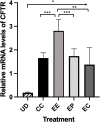Functional evaluation of the cystic fibrosis transmembrane conductance regulator in the endocervix†
- PMID: 35532160
- PMCID: PMC9476216
- DOI: 10.1093/biolre/ioac090
Functional evaluation of the cystic fibrosis transmembrane conductance regulator in the endocervix†
Abstract
The cystic fibrosis transmembrane conductance regulator (CFTR) is an apical membrane chloride/bicarbonate ion channel in epithelial cells. Mutations in CFTR cause cystic fibrosis, a disease characterized by thickened mucus secretions and is associated with subfertility and infertility. CFTR function has been well characterized in vitro and in vivo in airway and other epithelia studies. However, little is known about CFTR function in the cervix in health and its contribution to cyclic regulation of fertility from endocervical mucus changes. Contributing to this research gap is the lack of information on the effect of sex steroid hormones on CFTR expression in cervical epithelial cells across the menstrual cycle. Herein, we demonstrate the hormonal regulation of CFTR expression in endocervical cells both in vitro and in vivo, and that conditionally reprogrammed endocervical epithelial cells can be used to interrogate CFTR ion channel function. CFTR activity was demonstrated in vitro using electrophysiological methods and functionally inhibited by the CFTR-specific inhibitors inh-172 and GlyH-101. We also report that CFTR expression is increased by estradiol in the macaque cervix both in vitro and in vivo in Rhesus macaques treated with artificial menstrual cycles. Estrogen upregulation of CFTR is blocked in vivo by cotreatment with progesterone. Our findings provide the most comprehensive evidence to date that steroid hormones drive changes in CFTR expression. These data are integral to understanding the role of CFTR as a fertility regulator in the endocervix.
Keywords: cervix; contraception; cystic fibrosis transmembrane conductance regulator; female reproductive tract; fertility; primates using hormone receptors; reprogramming.
© The Author(s) 2022. Published by Oxford University Press on behalf of Society for the Study of Reproduction. All rights reserved. For permissions, please e-mail: journals.permissions@oup.com.
Figures








Similar articles
-
Hormonal regulation of non-cystic fibrosis transmembrane conductance regulator ion channels in the endocervix.F S Sci. 2023 May;4(2):163-171. doi: 10.1016/j.xfss.2023.03.002. Epub 2023 Mar 11. F S Sci. 2023. PMID: 36907435 Free PMC article.
-
The role of CFTR channel in female infertility.Hum Fertil (Camb). 2023 Dec;26(5):1228-1237. doi: 10.1080/14647273.2022.2161427. Epub 2022 Dec 28. Hum Fertil (Camb). 2023. PMID: 36576330 Review.
-
Cystic fibrosis transmembrane conductance regulator-mRNA delivery: a novel alternative for cystic fibrosis gene therapy.J Gene Med. 2013 Nov-Dec;15(11-12):414-26. doi: 10.1002/jgm.2748. J Gene Med. 2013. PMID: 24123772
-
The Mechanistic Links between Insulin and Cystic Fibrosis Transmembrane Conductance Regulator (CFTR) Cl- Channel.Int J Mol Sci. 2017 Aug 14;18(8):1767. doi: 10.3390/ijms18081767. Int J Mol Sci. 2017. PMID: 28805732 Free PMC article. Review.
-
Correlating genotype with phenotype using CFTR-mediated whole-cell Cl- currents in human nasal epithelial cells.J Physiol. 2022 Mar;600(6):1515-1531. doi: 10.1113/JP282143. Epub 2021 Dec 8. J Physiol. 2022. PMID: 34761808
Cited by
-
Hormonal regulation of non-cystic fibrosis transmembrane conductance regulator ion channels in the endocervix.F S Sci. 2023 May;4(2):163-171. doi: 10.1016/j.xfss.2023.03.002. Epub 2023 Mar 11. F S Sci. 2023. PMID: 36907435 Free PMC article.
-
Acquired dysfunction of CFTR underlies cystic fibrosis-like disease of the canine gallbladder.Am J Physiol Gastrointest Liver Physiol. 2024 Oct 1;327(4):G513-G530. doi: 10.1152/ajpgi.00145.2024. Epub 2024 Jul 23. Am J Physiol Gastrointest Liver Physiol. 2024. PMID: 39041675
-
New Insights and Potential Therapeutic Interventions in Metabolic Diseases.Int J Mol Sci. 2023 Jun 26;24(13):10672. doi: 10.3390/ijms241310672. Int J Mol Sci. 2023. PMID: 37445852 Free PMC article. Review.
-
Modulation of vulvovaginal atrophy (VVA) by Gelam honey in bilateral oophorectomized rats.Front Endocrinol (Lausanne). 2023 Feb 27;14:1031066. doi: 10.3389/fendo.2023.1031066. eCollection 2023. Front Endocrinol (Lausanne). 2023. PMID: 36923220 Free PMC article.
-
Changes of androgen and corticosterone metabolites excretion and conversion in cystic fibrosis.Front Endocrinol (Lausanne). 2023 Aug 29;14:1244127. doi: 10.3389/fendo.2023.1244127. eCollection 2023. Front Endocrinol (Lausanne). 2023. PMID: 37711888 Free PMC article.
References
-
- Ratjen F, Döring G. Cystic fibrosis. Lancet 2003; 361:681–689. - PubMed
-
- Gervais R, Dumur V, Letombe B, Larde A, Rigot J-M, Roussel P, Lafitte J-J.. Hypofertility with thick cervical mucus: another mild form of cystic fibrosis? JAMA 1996; 276:1638–1638. - PubMed
-
- Oppenheimer EA, Case AL, Esterly JR, Rothberg RM. Cervical mucus in cystic fibrosis: a possible cause of infertility. Am J Obstet Gynecol 1970; 108:673–674. - PubMed
-
- Schoyer KD, Gilbert F, Rosenwaks Z. Infertility and abnormal cervical mucus in two sisters who are compound heterozygotes for the cystic fibrosis (CF) ΔF508 and R117H/7T mutations. Fertil Steril 2008; 90:1201.e19–1201.e22. - PubMed
Publication types
MeSH terms
Substances
Grants and funding
LinkOut - more resources
Full Text Sources
Medical
Miscellaneous

